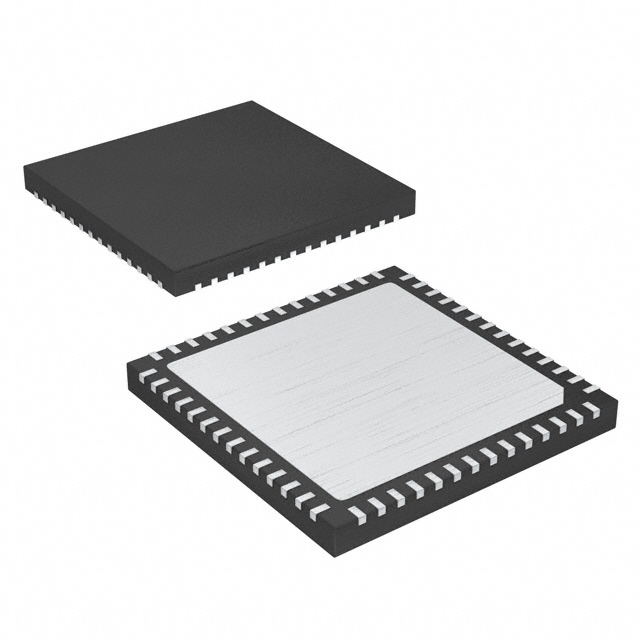Xem thông số kỹ thuật để biết chi tiết sản phẩm.

ADC16DX370RMER
Product Overview
Category: Analog-to-Digital Converter (ADC)
Use: The ADC16DX370RMER is a high-performance, dual-channel ADC designed for applications requiring precise and fast analog-to-digital conversion. It is commonly used in various industries such as telecommunications, medical imaging, radar systems, and scientific research.
Characteristics: - High-speed sampling rate - Wide input voltage range - Low power consumption - High resolution - Excellent linearity and accuracy
Package: The ADC16DX370RMER comes in a compact and durable package, ensuring easy integration into electronic systems. It is available in a surface-mount package, allowing for efficient PCB assembly.
Essence: The essence of the ADC16DX370RMER lies in its ability to convert analog signals into digital data with exceptional precision and speed. This enables accurate representation and analysis of real-world signals in digital systems.
Packaging/Quantity: Each package of the ADC16DX370RMER contains one unit of the ADC.
Specifications
- Resolution: 16 bits
- Sampling Rate: Up to 370 Mega Samples per Second (MSPS)
- Input Voltage Range: ±5V
- Power Supply: +3.3V
- Operating Temperature Range: -40°C to +85°C
- Interface: Serial Peripheral Interface (SPI)
Detailed Pin Configuration
The ADC16DX370RMER has a total of 48 pins, which are assigned specific functions. The pin configuration is as follows:
- VDDA: Analog power supply
- VDDD: Digital power supply
- VREFP: Positive reference voltage input
- VREFN: Negative reference voltage input
- VINP0: Positive input channel 0
- VINN0: Negative input channel 0
- VINP1: Positive input channel 1
- VINN1: Negative input channel 1
- CLKP: Clock input positive
- CLKN: Clock input negative
- ... (Provide a detailed pin configuration for all pins)
Functional Features
- Dual-channel operation for simultaneous conversion of two analog signals
- High-speed sampling rate allows for capturing fast-changing signals accurately
- Low power consumption ensures energy efficiency in electronic systems
- Excellent linearity and accuracy result in precise digital representation of analog signals
- Flexible interface options for seamless integration with various microcontrollers and digital systems
Advantages and Disadvantages
Advantages: - High-resolution conversion - Fast sampling rate - Wide input voltage range - Low power consumption - Accurate and precise conversion
Disadvantages: - Relatively higher cost compared to lower-end ADCs - Requires careful PCB layout and signal integrity considerations
Working Principles
The ADC16DX370RMER utilizes a successive approximation register (SAR) architecture to convert analog signals into digital data. It employs a high-speed sampling mechanism, where the input analog signal is sampled at a very high rate and then processed through internal circuitry to generate the corresponding digital output.
Detailed Application Field Plans
The ADC16DX370RMER finds extensive application in various fields, including:
- Telecommunications: Used in base stations, wireless communication systems, and network infrastructure equipment for signal processing and modulation/demodulation applications.
- Medical Imaging: Enables high-resolution image acquisition in medical imaging devices such as ultrasound machines, CT scanners, and MRI systems.
- Radar Systems: Utilized in radar systems for accurate target detection, tracking, and signal analysis.
- Scientific Research: Supports data acquisition and analysis in scientific research applications, including physics experiments, astronomy, and environmental monitoring.
Detailed and Complete Alternative Models
- ADC14DX370RMER: Similar to the ADC16DX370RMER but with a 14-bit resolution.
- ADC18DX370RMER: Similar to the ADC16DX370RMER but with an 18-bit resolution.
- ADC16DX380RMER: A higher-speed variant of the ADC16DX370RMER, offering a sampling rate of up to 380 MSPS.
(Note: This is not an exhaustive list of alternative models. Please refer to the manufacturer's documentation for a complete list.)
In conclusion, the ADC16DX370RMER is a high-performance dual-channel ADC that offers exceptional precision, speed, and versatility. Its wide range of applications and advanced features make it a valuable component in various industries requiring accurate analog-to-digital conversion.
Liệt kê 10 câu hỏi và câu trả lời thường gặp liên quan đến ứng dụng ADC16DX370RMER trong giải pháp kỹ thuật
Sure! Here are 10 common questions and answers related to the application of ADC16DX370RMER in technical solutions:
Q: What is ADC16DX370RMER? A: ADC16DX370RMER is a high-performance analog-to-digital converter (ADC) designed for various applications in technical solutions.
Q: What is the resolution of ADC16DX370RMER? A: ADC16DX370RMER has a resolution of 16 bits, allowing for precise digital representation of analog signals.
Q: What is the sampling rate of ADC16DX370RMER? A: ADC16DX370RMER supports a maximum sampling rate of 370 Mega-samples per second (MSPS), enabling fast data acquisition.
Q: What is the input voltage range of ADC16DX370RMER? A: The input voltage range of ADC16DX370RMER is typically ±0.5V, but it can be adjusted using external components.
Q: Can ADC16DX370RMER handle differential inputs? A: Yes, ADC16DX370RMER is designed to handle differential inputs, which helps in reducing noise and improving signal integrity.
Q: Does ADC16DX370RMER support multiple input channels? A: Yes, ADC16DX370RMER has two independent input channels, allowing for simultaneous sampling of two different signals.
Q: What is the power supply requirement for ADC16DX370RMER? A: ADC16DX370RMER requires a single power supply voltage of +1.8V, making it suitable for low-power applications.
Q: Is there any built-in digital processing in ADC16DX370RMER? A: No, ADC16DX370RMER is a standalone ADC and does not have built-in digital processing capabilities. It focuses on high-quality analog-to-digital conversion.
Q: What interface does ADC16DX370RMER use to communicate with microcontrollers or processors? A: ADC16DX370RMER uses a parallel interface, such as the low-voltage differential signaling (LVDS) interface, for data transfer to external devices.
Q: Can ADC16DX370RMER be used in industrial applications? A: Yes, ADC16DX370RMER is suitable for various industrial applications, including test and measurement equipment, data acquisition systems, and communication systems.
Please note that these answers are general and may vary depending on specific implementation details and requirements.

